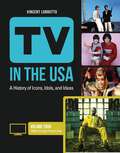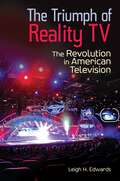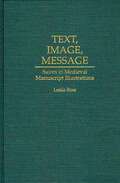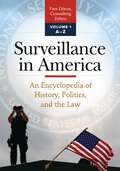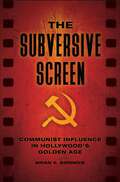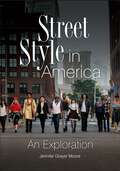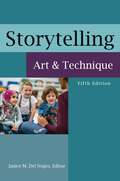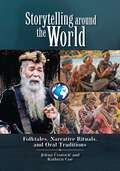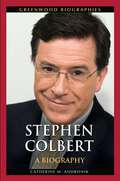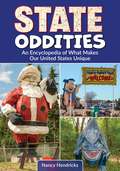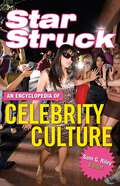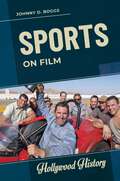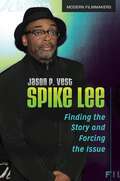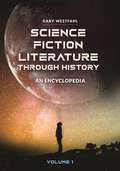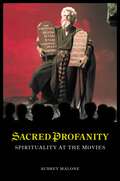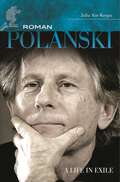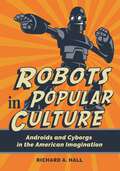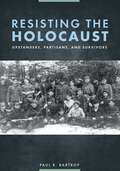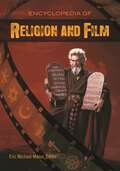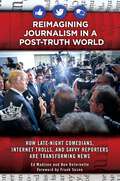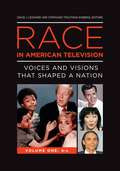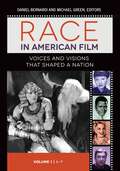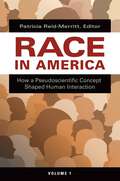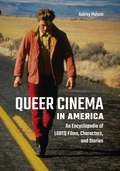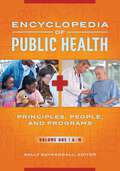- Table View
- List View
TV in the USA [3 volumes]: A History of Icons, Idols, and Ideas [3 volumes]
by Vincent LoBruttoThis three-volume set is a valuable resource for researching the history of American television. An encyclopedic range of information documents how television forever changed the face of media and continues to be a powerful influence on society.What are the reasons behind enduring popularity of television genres such as police crime dramas, soap operas, sitcoms, and "reality TV"? What impact has television had on the culture and morality of American life? Does television largely emulate and reflect real life and society, or vice versa? How does television's influence differ from that of other media such as newspapers and magazines, radio, movies, and the Internet? These are just a few of the questions explored in the three-volume encyclopedia TV in the USA: A History of Icons, Idols, and Ideas.This expansive set covers television from 1950 to the present day, addressing shows of all genres, well-known programs and short-lived series alike, broadcast on the traditional and cable networks. All three volumes lead off with a keynote essay regarding the technical and historical features of the decade(s) covered. Each entry on a specific show investigates the narrative, themes, and history of the program; provides comprehensive information about when the show started and ended, and why; and identifies the star players, directors, producers, and other key members of the crew of each television production. The set also features essays that explore how a particular program or type of show has influenced or reflected American society, and it includes numerous sidebars packed with interesting data, related information, and additional insights into the subject matter.
The Triumph of Reality TV: The Revolution in American Television
by Leigh H. EdwardsThis book provides an up-to-date account of how reality TV has developed, why it has become the most popular genre on television today, and how the explosion in reality TV signals new developments in American media culture.The reasons behind reality TV's continued popularity go beyond the sensationalism and low production cost of these programs: there is much more to the genre's continued success than just escapism or "guilty pleasure" TV. The Triumph of Reality TV: The Revolution in American Television identifies and explores five key media trends reality TV has used to continually draw in viewers and ensure success. These media trends include innovations in storytelling, making emotional appeals to viewers, and applying content from television to other media such as films, music albums, webisodes, online games, and smart phone apps. Author Leigh H. Edwards also analyzes how reality TV shows target themes of social conflict, such as changing ideas of the American family, and address common anxieties and tensions in American society such as gender, race, class, and economic struggle. A wide variety of reality shows—including American Idol, Celebrity Rehab, Jackass, Run's House, Survivor, and The Hills—are profiled. An appealing read for students, scholars, and general readers alike, this book provides fascinating insights into the complexities of a seemingly simplistic form of mass entertainment.
Text, Image, Message: Saints in Medieval Manuscript Illustrations (Contributions to the Study of Art and Architecture)
by Leslie D. RossRoss provides a broad survey of pictures and texts concerning saints, from the Early Christian through the late Gothic period. Both Western and Byzantine material is included. Beginning with the earliest pictures of and stories about saints, the book traces the evolution of hagiographic imagery primarily in manuscript contexts. Because of its cross-disciplinary nature, it will be of interest to audiences interested in Early Christian, Byzantine, and Western medieval culture: religion, society, politics, and art. No other book to date is organized similarly in providing detailed descriptions for the identification of medieval manuscripts with hagiographic texts and illustrations.
Surveillance in America [2 volumes]: An Encyclopedia of History, Politics, and the Law [2 volumes]
by Pam DixonAn excellent resource for high school and college students, this book surveys the size, scope, and nature of government surveillance in 21st-century America, with a particular focus on technology-enabled surveillance and its impact on privacy and other civil liberties.The advent of online, cellular, and other digital networks has enabled today's government surveillance operations to become more extensive and far more thorough than any other programs before them. Where does the line between taking actions to help ensure the safety of the general population against terrorism and other threats and the privacy of individual citizens lie? Is there any such clearly defined line anymore? This two-volume set examines the key issues surrounding government surveillance and privacy in 21st-century America, covering topics ranging from the surveillance conducted during colonial days, which inspired the Fourth Amendment, to the new high-tech developments that pose unprecedented potential challenges to the privacy of millions of Americans. Readers will gain insight into the complex challenge of interpreting the Fourth Amendment protections against warrantless, unreasonable government searches and understand how changes in the methods by which the U.S. government carries out counterterrorism and law enforcement activities influence its relationship with American citizens and businesses.
The Subversive Screen: Communist Influence in Hollywood's Golden Age
by Brian E. BirdnowA riveting chronicle of Communist Party efforts to propagate Communism in the United States, concurrent with Hollywood's "Golden Age" of creativity that came to define classical Hollywood cinema.From the Great Depression through World War II, the American Communist Party tried to take control of the motion picture industry. This comprehensive and chronological account of Communist influence in Hollywood surveys the topic from the Popular Front's fight against Fascism during the 1930s to the height of the House Un-American Activities Committee hearings in the late 1940s.Birdnow, an established historian and chronicler of domestic Communism, outlines Communist International's organizational efforts promoting international communism, focusing on the work of Communist political activists such as Willi Münzenberg, a media mogul with an international network; Gerhart Eisler, patron of a Hollywood composer; and Otto Katz, a high-profile publicist of the party line involved in movies in the 1930s and 1940s. The book explores the covert ways in which Hollywood Communists and Soviet sympathizers attempted to tailor movie scripts to suit the Soviet agenda and discusses Communist front groups such as the Hollywood Anti-Nazi League in great detail. Final chapters offer convincing proof that the directors, producers, and screenwriters blacklisted by studios for their possible Communist affiliations, known as the Hollywood Ten, were members of the Communist Party.
Street Style in America: An Exploration
by Dr Jennifer Grayer MooreA comprehensive resource that will prove invaluable to fashion historians, this book presents a detailed exploration of the breadth of visually arresting, consumer-driven styles that have emerged in America since the 20th century.What are the origins of highly specific denim fashions, such as bell bottoms, skinny jeans, and ripped jeans? How do mass media and popular culture influence today's street fashion? When did American fashion sensibilities shift from conformity as an ideal to youth-oriented standards where clothing could boldly express independence and self-expression? Street Style in America: An Exploration addresses questions like these and many others related to the historical and sociocultural context of street style, supplying both A–Z entries that document specific American street styles and illustrations with accompanying commentary.This book provides a detailed analysis of American street and subcultural styles, from the earliest example reaching back to the early 20th century to contemporary times. It reviews all aspects of dress that were part of a look, considering variations over time and connecting these innovations to fashionable dress practices that emerged in the wakes of these sartorial rebellions. The text presents detailed examinations of specific dress styles and also interrogates the manifold meanings of dress practices that break from the mainstream. This book is a comprehensive resource that will prove invaluable to fashion historians and provide fascinating reading for students and general audiences.
Storytelling: Art and Technique
by Janice M. Del NegroThis book serves as both a textbook and reference for faculty and students in LIS courses on storytelling and a professional guide for practicing librarians, particularly youth services librarians in public and school libraries.Storytelling: Art and Technique serves professors, students, and practitioners alike as a textbook, reference, and professional guide. It provides practical instruction and concrete examples of how to use the power of story to build literacy and presentation skills, as well as to create community in those same educational spaces.This text illustrates the value of storytelling, covers the history of storytelling in libraries, and offers valuable guidance for bringing stories to contemporary listeners, with detailed instructions on the selection, preparation, and presentation of stories. It also provides guidance around the planning and administration of a storytelling program. Topics include digital storytelling, open mics and slams, and the neuroscience of storytelling. An extensive and helpful section of resources for the storyteller is included in an expanded Part V of this edition.
Storytelling around the World: Folktales, Narrative Rituals, and Oral Traditions
by Jelena Cvorovic Kathryn CoeThis book provides students, instructors, and lay-readers with a cross-cultural understanding of storytelling as an art form that has existed for centuries, from the first spoken and sung stories to those that are drawn and performed today.This book serves as an indispensable resource for students and scholars interested in storytelling and in multicultural approaches to the arts. By taking an evolutionary approach, this book begins with a discussion of origin stories and continues through history to stories of the 21st century. The text not only engages the stories themselves, it also explains how individuals from all disciplines, from doctors and lawyers to priests and journalists, use stories to focus their readers' and listeners' attention and influence them.This text addresses stories and storytelling across both time (thousands of years) and geography, including in-depth descriptions of storytelling practices occurring in more than 40 different cultures around the world. Part I consists of thematic essays, exploring such topics as the history of storytelling, common elements across cultures, different media, lessons stories teach us, and storytelling today. Part II looks at more than 40 different cultures, with entries following the same outline: Overview, Storytellers: Who Tell the Stories, and When, Creation Mythologies, Teaching Tales and Values, and Cultural Preservation. Several tales/tale excerpts accompany each entry.
Stephen Colbert: A Biography (Greenwood Biographies)
by Catherine M. AndronikThis book explores how comedian Stephen Colbert's satiric views of American life have captured the imagination of viewers around the world—and sharpened these individuals' own critical interpretations and opinions on current events.Stephen Colbert may be "just a comedian"—one not all audiences find funny, especially among those who have been mercilessly lampooned by him—but there is no arguing that the condescending, bombastic, and largely ignorant pundit he plays on Comedy Central has brought awareness of current events and political happenings to a substantially larger portion of the American population.The only available biography on Stephen Colbert, this book examines his life story and details how he became one of the most influential people on current American culture. Beginning with coverage of Colbert's childhood, the chapters discuss his education, highlighting his interest in drama; describe his introduction to the world of comedy; review his contributions as a "correspondent" on The Daily Show with Jon Stewart; and focus on Colbert's accomplishments and antics as the star of his faux news program that debuted in the fall of 2005, The Colbert Report.
State Oddities: An Encyclopedia of What Makes Our United States Unique
by Nancy HendricksState Oddities takes a different kind of look at the American nation, spotlighting the fun foibles, peculiarities, and twists in each of the 50 states that are (mostly) united under the Stars and Stripes.State Oddities is a fascinating trip through the 50 states for students studying America, teachers planning classroom activities, and general readers who will enjoy an eye-opening journey through the nation's fun side. It offers a compelling look at the character of America through the individuality of 50 very distinct states that together form the USA. This book paints a picture of the broad sweep of the American story, offering a gateway to the country as it developed into one nation filled with individual states that can be remarkably different from each other, yet unified under such national symbols as the American flag and "The Star-Spangled Banner."The author of State Oddities has become known as a master of "painless history," telling America's story in a sparkling style along with the historian's eye for fascinating detail. On the book's cross-country journey, the reader will find that it differs from other works by taking a fresh look at stories we think we know.
Star Struck: An Encyclopedia of Celebrity Culture
by Sam G. RileyThis balanced examination looks at America's pervasive celebrity culture, concentrating on the period from 1950 to the present day.Star Struck: An Encyclopedia of Celebrity Culture is neither a stern critic nor an apologist for celebrity infatuation, a phenomenon that sometimes supplants more weighty matters yet constitutes one of our nation's biggest exports. This encyclopedia covers American celebrity culture from 1950 to 2008, examining its various aspects—and its impact—through 86 entries by 30 expert contributors.Demonstrating that all celebrities are famous, but not all famous people are celebrities, the book cuts across the various entertainment medias and their legions of individual "stars." It looks at sports celebrities and examines the role of celebrity in more serious pursuits and institutions such as the news media, corporations, politics, the arts, medicine, and the law. Also included are entries devoted to such topics as paranoia and celebrity, one-name celebrities, celebrity nicknames, family unit celebrity, sidekick celebrities, and even criminal celebrities.
Sports on Film (Hollywood History)
by Johnny D. BoggsSports on Film takes readers behind the scenes of how movies get made and puts them in the stands for some of the key moments in sports in America.Sports on Film documents key events in American sports history through the films that depict them, starting with the integration of major-league baseball when Jackie Robinson signed with the Brooklyn Dodgers. Other significant events and personalities examined include the college basketball point-shaving incident of the 1950s; journalist George Plimpton's attempt to go through the Detroit Lions' NFL training camp in the early 1960s; the originations and popularity of rodeo; the brief run of women's professional baseball during World War II; the underdog racehorse Seabiscuit during the Great Depression; the rise of African American boxer Muhammad Ali; the unique 1970s "Battle of the Sexes" tennis event between Bobby Riggs and Billie Jean King; and Ford Motor Company's run in the 1960s to take motorsports to Europe's premier event in Le Mans, France.
Spike Lee: Finding the Story and Forcing the Issue (Modern Filmmakers)
by Jason P. VestSpike Lee's journey from guerrilla filmmaker to Hollywood insider is explored in light of his personal background, the cultural influence of his films, and the extensive scholarship his movies have inspired.This insightful study probes the iconic filmmaker's career as a director and shaper of American culture. It not only sheds light on the ways in which Lee's background, influences, and outlook affect his films but also discusses how he participates in, transforms, and transcends the tradition of black American filmmaking. Each chapter offers a critical assessment of at least one, and sometimes multiple, Lee films, examining their production history; their place in Lee's filmography; and their aesthetic, cultural, and historical significance. Readers will come away from this first scholarly assessment of Lee's career and work with a better understanding of his penchant for stirring up controversy about significant social, political, and artistic issues as well as his role as an American artist who provokes his audiences as much as he pacifies them.
Science Fiction Literature through History [2 volumes]: An Encyclopedia [2 volumes]
by Gary WestfahlThis book provides students and other interested readers with a comprehensive survey of science fiction history and numerous essays addressing major science fiction topics, authors, works, and subgenres written by a distinguished scholar.This encyclopedia deals with written science fiction in all of its forms, not only novels and short stories but also mediums often ignored in other reference books, such as plays, poems, comic books, and graphic novels. Some science fiction films, television programs, and video games are also mentioned, particularly when they are relevant to written texts. Its focus is on science fiction in the English language, though due attention is given to international authors whose works have been frequently translated into English.Since science fiction became a recognized genre and greatly expanded in the 20th century, works published in the 20th and 21st centuries are most frequently discussed, though important earlier works are not neglected. The texts are designed to be helpful to numerous readers, ranging from students first encountering science fiction to experienced scholars in the field.
Sacred Profanity: Spirituality at the Movies
by Aubrey MaloneThis book offers a history of films with Biblical, spiritual, and supernatural themes.This volume follows the evolution of one of the Hollywood's longest running thematic concerns. From the silent era to the present, Sacred Profanity: Spirituality at the Movies examines the rich diversity of films with spiritual themes—films that reflect our own fascination with the divine and supernatural, while evoking the specific times in which they were created.From Birth of a Nation to Angels and Demons, Sacred Profanity discusses over 180 films with an insightful, movie lover's approach. Coverage encompasses Biblical stories like King of Kings; films about spiritual characters, such as The Nun's Story; foreign masterpieces like The Seventh Seal; movies that incorporate spiritual symbolism, such as Taxi Driver and Cool Hand Luke; horrifying visions of the Satanic like The Exorcist, and controversial works like The Last Temptation of Christ. The book also looks at the history of Hollywood's attempt to maintain moral order through censorship, as well as the growing influence of filmmakers' own spiritual beliefs on the movies we see.
Roman Polanski: A Life in Exile (Modern Filmmakers)
by Julia Ain-KrupaThis book offers an examination of the films of Roman Polanski, focusing on the impact that his life as an exile has had upon his work.Roman Polanski: A Life in Exile is a revealing look at this acclaimed filmmaker whose life in exile seems to have made his films all the more personal and powerful. Written by a film critic, this insightful book follows Polanski's story from his childhood in a World War II Jewish ghetto to his early films in Poland; from his American breakout, Rosemary's Baby, to his wife's murder by the Manson family; from the spectacular return of Chinatown, to his exile as a convicted sex criminal, to the monumental career peak, The Pianist. The Holocaust, the oppression of communism, the shattering of the swinging 60s, the decadence of Hollywood, the life of a fugitive—Polanski experienced all of these firsthand, and understanding those experiences provides a fascinating pathway through his work.
Robots in Popular Culture: Androids and Cyborgs in the American Imagination
by Richard A. HallRobots in Popular Culture: Androids and Cyborgs in the American Imagination seeks to provide one go-to reference for the study of the most popular and iconic robots in American popular culture.In the last 10 years, technology and artificial intelligence (AI) have become not only a daily but a minute-by-minute part of American life—more integrated into our lives than anyone would have believed even a generation before. Americans have long known the adorable and helpful R2-D2 and the terrible possibilities of Skynet and its army of Terminators. Throughout, we have seen machines as valuable allies and horrifying enemies. Today, Americans cling to their mobile phones with the same affection that Luke Skywalker felt for the squat R2-D2. Meanwhile, our phones, personal computers, and cars have attained the ability to know and learn everything about us.This volume opens with essays about robots in popular culture, followed by 100 A–Z entries on the most famous AIs in film, comics, and more. Sidebars highlight ancillary points of interest, such as authors, creators, and tropes that illuminate the motives of various robots. The volume closes with a glossary of key terms and a bibliography providing students with resources to continue their study of what robots tell us about ourselves.
Resisting the Holocaust: Upstanders, Partisans, and Survivors
by Professor Paul R. BartropThis book enables readers to learn about upstanders, partisans, and survivors from first-hand perspectives that reveal the many forms of resistance—some bold and defiant, some subtle—to the Nazis during the Holocaust.What did those who resisted the Nazis during the 1930s through 1945—known now as "the Righteous"—do when confronted with the Holocaust? How did those who resorted to physical acts of resistance to fight the Nazis in the ghettos, the concentration camps, and the forests summon the courage to form underground groups and organize their efforts?This book presents a comprehensive examination of more than 150 remarkable people who said "no" to the Nazis when confronted by the Holocaust of the Jews. They range from people who undertook armed resistance to individuals who risked—and sometimes lost—their lives in trying to rescue Jews or spirit them away to safety. In many cases, the very act of survival in the face of extreme circumstances was a form of resistance. This important book explores the many facets of resistance to the Holocaust that took place less than 100 years ago, providing valuable insights to any reader seeking evidence of how individuals can remain committed to the maintenance of humanitarian traditions in the darkest of times.
Encyclopedia of Religion and Film
by Eric Michael Mazur, EditorComprising 91 A–Z entries, this encyclopedia provides a broad and comprehensive introduction to the topic of religion within film.Technology has enabled films to reach much wider audiences, enabling today's viewers to access a dizzying number of films that employ diverse symbolism and communicate a vast array of viewpoints. Encyclopedia of Religion and Film will provide such an audience with the tools to begin their own exploration of the deeper meanings of these films and grasp the religious significance within.Organized alphabetically, this encyclopedia provides more than 90 entries on the larger religious traditions, the major film-producing regions of the globe, the films that have stirred controversy, the most significant religious symbols, and the more important filmmakers. The included topics provide substantially more information on the intersection of religion and film than any of the similar volumes currently available. While the emphasis is on the English-speaking world and the films produced therein, there is also substantial representation of non-English, non-Western film and filmmakers, providing significant intercultural coverage to the topic.
Reimagining Journalism in a Post-Truth World: How Late-Night Comedians, Internet Trolls, and Savvy Reporters Are Transforming News
by Ed Madison Ben DeJarnetteAmidst "alternative facts" and "post-truth" politics, news journalism is more important and complex than ever. This book examines journalism's evolution within digital media's ecosystem where lies often spread faster than truth, and consumers expect conversations, not lectures.Tthe 2016 U.S. presidential election delivered a stunning result, but the news media's breathless coverage of it was no surprise. News networks turned debates into primetime entertainment, reporters spent more time covering poll results than public policy issues, and the cozy relationship between journalists and political insiders helped ensure intrigue and ratings, even as it eroded journalism's role as democracy's "Fourth Estate." Against this sobering backdrop, a broadcast news veteran and a millennial newshound consider how journalism can regain the public's trust by learning from pioneers both within and beyond the profession. Connecting the dots between faux news, "fake news," and real news, coauthors Madison and DeJarnette provide an unflinching analysis of where mainstream journalism went wrong—and what the next generation of reporters can do to make it right. The significance of Donald Trump's presidency is not lost on the authors, but Reimagining Journalism in a Post-Truth World is not a post-mortem of the 2016 presidential election, nor is it a how-to guide for reporting on Trump's White House. Instead, this accessible and engaging book offers a broader perspective on contemporary journalism, pairing lively anecdotes with insightful analysis of long-term trends and challenges. Drawing on their expertise in media innovation and entrepreneurship, the authors explore how comedians like John Oliver, Trevor Noah, and Samantha Bee are breaking (and reshaping) the rules of political journalism; how legacy media outlets like The Boston Globe, The Washington Post, and The New York Times are retooling for the digital age; and how newcomers like Vice, Hearken, and De Correspondent are innovating new models for reporting and storytelling. Anyone seeking to make sense of modern journalism and its intersections with democracy will want to read this book.
Race in American Television [2 volumes]: Voices and Visions That Shaped a Nation [2 volumes]
by David J. Leonard and Stephanie Troutman RobbinsThis two-volume encyclopedia explores representations of people of color in American television. It includes overview essays on early, classic, and contemporary television and the challenges for, developments related to, and participation of minorities on and behind the screen.Covering five decades, this encyclopedia highlights how race has shaped television and how television has shaped society. Offering critical analysis of moments and themes throughout television history, Race in American Television shines a spotlight on key artists of color, prominent shows, and the debates that have defined television since the civil rights movement. This book also examines the ways in which television has been a site for both reproduction of stereotypes and resistance to them, providing a basis for discussion about racial issues in the United States.This set provides a significant resource for students and fans of television alike, not only educating but also empowering readers with the necessary tools to consume and watch the small screen and explore its impact on the evolution of racial and ethnic stereotypes in U.S. culture and beyond. Understanding the history of American television contributes to deeper knowledge and potentially helps us to better apprehend the plethora of diverse shows and programs on Netflix, Hulu, YouTube, and other platforms today.
Race in American Film [3 volumes]: Voices and Visions That Shaped a Nation [3 volumes]
by Daniel Bernardi and Michael Green, EditorsThis expansive three-volume set investigates racial representation in film, providing an authoritative cross-section of the most racially significant films, actors, directors, and movements in American cinematic history.Hollywood has always reflected current American cultural norms and ideas. As such, film provides a window into attitudes about race and ethnicity over the last century. This comprehensive set provides information on hundreds of films chosen based on scholarly consensus of their importance regarding the subject, examining aspects of race and ethnicity in American film through the historical context, themes, and people involved.This three-volume set highlights the most important films and artists of the era, identifying films, actors, or characterizations that were considered racist, were tremendously popular or hugely influential, attempted to be progressive, or some combination thereof. Readers will not only learn basic information about each subject but also be able to contextualize it culturally, historically, and in terms of its reception to understand what average moviegoers thought about the subject at the time of its popularity—and grasp how the subject is perceived now through the lens of history.
Race in America [2 volumes]: How a Pseudoscientific Concept Shaped Human Interaction [2 volumes]
by Patricia Reid-Merritt, EditorFocusing on the socially explosive concept of race and how it has affected human interactions, this work examines the social and scientific definitions of race, the implementation of racialized policies and practices, the historical and contemporary manifestations of the use of race in shaping social interactions within U.S. society and elsewhere, and where our notions of race will likely lead.More than a decade and a half into the 21st century, the term "race" remains one of the most emotionally charged words in the human language. While race can be defined as "a local geographic or global human population distinguished as a more or less distinct group by genetically transmitted physical characteristics," the concept of race can better be understood as a socially defined construct—a system of human classification that carries tremendous weight, yet is complex, confusing, contradictory, controversial, and imprecise. This collection of essays focuses on the socially explosive concept of race and how it has shaped human interactions across civilization. The contributed work examines the social and scientific definitions of race, the implementation of racialized policies and practices, and the historical and contemporary manifestations of the use of race in shaping social interactions (primarily) in the United States—a nation where the concept of race is further convoluted by the nation's extensive history of miscegenation as well as the continuous flow of immigrant groups from countries whose definitions of race, ethnicity, and culture remain fluid. Readers will gain insights into subjects such as how we as individuals define ourselves through concepts of race, how race affects social privilege, "color blindness" as an obstacle to social change, legal perspectives on race, racialization of the religious experience, and how the media perpetuates racial stereotypes.
Queer Cinema in America: An Encyclopedia of LGBTQ Films, Characters, and Stories
by Aubrey MaloneThis reference helps readers navigate the perilous odyssey those of an LGBTQ orientation had to face in an age less enlightened than our own, when an attraction to members of the same gender could lead to horrendous abuse.Just as American society has changed dramatically from decade to decade, so has queer cinema. Taking us from a time when LGBTQ characters were often represented as either caricatures or figures of farce, this lively yet authoritative reference explores the sea change ushered in by such stars as Greta Garbo and Marlene Dietrich in the 1930s and '40s, androgynous figures such as Montgomery Clift, James Dean, and Marlon Brando in the '50s, and closeted gay men such as Rock Hudson and Liberace, whose double lives were exposed by the scourge of AIDS.Included are alphabetically arranged entries on stars, directors, films, themes, and other topics related to queer cinema in America, including films and persons from outside the U.S. who nonetheless figured prominently in America popular culture. Entries cite works for further reading, sidebars provide snippets of interesting trivia, a timeline highlights key events, and a selected, general, end-of-work bibliography cites the most important major works on the topic.
Encyclopedia of Public Health [2 volumes]: Principles, People, and Programs [2 volumes]
by Editor Sally KuykendallProviding context to today's public health practices and broad coverage of topics, this book demonstrates how cross-disciplinary studies are critical to addressing current health issues.The concepts of public health and the methods we use to care for and promote the health of people in communities, groups, and our nation as a whole are of interest to all health professionals. Comprising contributions from historians, scholars, researchers, sociologists, and other public health professionals, the Encyclopedia of Public Health: Principles, People, and Programs offers a firsthand, in-depth view of public health as it applies to everyday life and practice. The encyclopedia contains a wealth of information on critical theories, people, and movements and shows how various disciplines can work together to create healthy communities and practices for many people. As a secondary objective, the book encourages future generations to actively participate in public health. This reference covers the defining moments in the development of public health, from ancient times to the modern day, and offers entries with historical information and examinations of current controversies as they relate to recurring social conflicts. The entries provide a breadth and depth of content that is accessible to a wide readership. Readers will understand the benefits of physical activity and good nutrition as well as the psychology behind the choices that we make and how early life and social experiences can influence behaviors even decades after the event. The wide variety of topics covered includes the life expectancy of Americans at birth, the Tuskegee syphilis study, and marijuana use, and will give readers an informed perspective on past public health successes and likely directions for the future.
